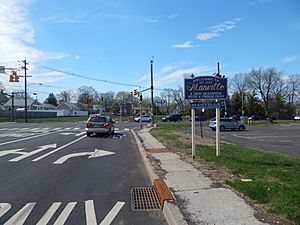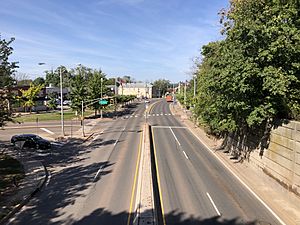Manville, New Jersey facts for kids
Quick facts for kids
Manville, New Jersey
|
|
|---|---|
|
Borough
|
|
| Borough of Manville | |
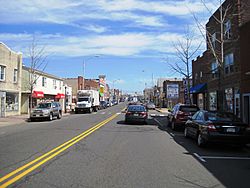
Central business district of Manville
|
|

Map of Manville in Somerset County. Inset: Location of Somerset County highlighted in the State of New Jersey.
|
|
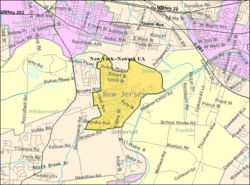
Census Bureau map of Manville, New Jersey
|
|
| Country | |
| State | |
| County | |
| Incorporated | April 18, 1929 |
| Government | |
| • Type | Borough |
| • Body | Borough Council |
| Area | |
| • Total | 2.45 sq mi (6.34 km2) |
| • Land | 2.36 sq mi (6.11 km2) |
| • Water | 0.09 sq mi (0.23 km2) 3.59% |
| Area rank | 377th of 565 in state 15th of 21 in county |
| Elevation | 56 ft (17 m) |
| Population | |
| • Total | 10,344 |
| • Estimate
(2019)
|
10,121 |
| • Rank | 237th of 566 in state 11th of 21 in county |
| • Density | 4,382.0/sq mi (1,691.9/km2) |
| • Density rank | 134th of 566 in state 5th of 21 in county |
| Time zone | UTC−05:00 (Eastern (EST)) |
| • Summer (DST) | UTC−04:00 (Eastern (EDT)) |
| ZIP Code |
08835
|
| Area code(s) | 908 |
| FIPS code | 3403543620 |
| GNIS feature ID | 0885291 |
Manville is a borough in Somerset County, New Jersey, United States. The borough is located in the heart of the Raritan Valley region and is a part of the New York metropolitan area. As of the 2010 United States Census, the borough's population was 10,344, reflecting an increase of one person (+0.0%) from the 10,343 counted in the 2000 Census, which had in turn declined by 224 (-2.1%) from the 10,567 counted in the 1990 Census. Manville was named after the Johns-Manville Corporation, which maintained a large manufacturing facility in the borough for decades.
Historically, many of Manville's residents are of Slavic — mostly eastern Polish (23.1% of the borough's population in 2000) and western Ukrainian descent — with many businesses and restaurants geared towards the Polish-American community located along Main Street (County Route 533).
Manville was formed by an act of the New Jersey Legislature on April 1, 1929, subject to the results of a referendum held on April 18, 1929.
Contents
Geography
According to the United States Census Bureau, the borough had a total area of 2.449 square miles (6.342 km2), including 2.361 square miles (6.114 km2) of land and 0.088 square miles (0.228 km2) of water (3.60%).
Unincorporated communities, localities and place names located partially or completely within the borough include Millsboro.
The borough borders Bridgewater Township, Franklin Township and Hillsborough Township.
Much of Manville is in a low-lying flood plain and is surrounded by rivers and streams on all but the western side which borders neighboring Hillsborough Township by land. The Raritan River forms the northern boundary of the borough and is met by the Millstone River which forms the eastern boundary of the borough, where a weir exists at the confluence of the rivers which is used for water intake purposes by New Jersey American Water.
Demographics
| Historical population | |||
|---|---|---|---|
| Census | Pop. | %± | |
| 1930 | 5,441 | — | |
| 1940 | 6,065 | 11.5% | |
| 1950 | 8,597 | 41.7% | |
| 1960 | 10,995 | 27.9% | |
| 1970 | 13,029 | 18.5% | |
| 1980 | 11,278 | −13.4% | |
| 1990 | 10,567 | −6.3% | |
| 2000 | 10,343 | −2.1% | |
| 2010 | 10,344 | 0.0% | |
| 2019 (est.) | 10,121 | −2.2% | |
| Population sources: 1930 1930-1990 2000 2010 |
|||
Census 2010
As of the census of 2010, there were 10,344 people, 4,016 households, and 2,663 families residing in the borough. The population density was 4,382.0 per square mile (1,691.9/km2). There were 4,277 housing units at an average density of 1,811.9 per square mile (699.6/km2)*. The racial makeup of the borough was 86.35% (8,932) White, 2.72% (281) Black or African American, 0.10% (10) Native American, 1.99% (206) Asian, 0.00% (0) Pacific Islander, 6.50% (672) from other races, and 2.35% (243) from two or more races. [[Hispanic (U.S. Census)|Hispanic or Latino of any race were 18.98% (1,963) of the population.
There were 4,016 households out of which 26.8% had children under the age of 18 living with them, 47.2% were married couples living together, 12.6% had a female householder with no husband present, and 33.7% were non-families. 27.0% of all households were made up of individuals, and 11.0% had someone living alone who was 65 years of age or older. The average household size was 2.58 and the average family size was 3.12.
In the borough, the population was spread out with 20.2% under the age of 18, 9.0% from 18 to 24, 28.6% from 25 to 44, 28.0% from 45 to 64, and 14.2% who were 65 years of age or older. The median age was 39.6 years. For every 100 females there were 100.5 males. For every 100 females ages 18 and old there were 99.3 males.
The Census Bureau's 2006-2010 American Community Survey showed that (in 2010 inflation-adjusted dollars) median household income was $55,601 (with a margin of error of +/- $4,325) and the median family income was $63,864 (+/- $11,426). Males had a median income of $48,356 (+/- $4,062) versus $40,954 (+/- $5,868) for females. The per capita income for the borough was $26,636 (+/- $1,894). About 1.9% of families and 4.6% of the population were below the poverty line, including 8.4% of those under age 18 and 3.2% of those age 65 or over.
Census 2000
As of the 2000 United States Census there were 10,343 people, 4,115 households, and 2,757 families residing in the borough. The population density was 4,167.5 people per square mile (1,610.3/km2). There were 4,296 housing units at an average density of 1,731.0 per square mile (668.8/km2). The racial makeup of the borough was 95.99% White, 0.45% African American, 0.07% Native American, 1.31% Asian, 0.03% Pacific Islander, 1.14% from other races, and 1.01% from two or more races. Hispanic or Latino of any race were 5.40% of the population.
23.1% of Manville's residents identified themselves as being of Polish ancestry, the second-highest in New Jersey (behind Wallington's 45.5%), for all places with 1,000 people listing their ancestry.
There were 4,115 households, out of which 26.5% had children under the age of 18 living with them, 50.3% were married couples living together, 11.9% had a female householder with no husband present, and 33.0% were non-families. 26.7% of all households were made up of individuals, and 12.3% had someone living alone who was 65 years of age or older. The average household size was 2.51 and the average family size was 3.05.
In the borough the population was spread out, with 20.7% under the age of 18, 7.2% from 18 to 24, 31.9% from 25 to 44, 22.5% from 45 to 64, and 17.7% who were 65 years of age or older. The median age was 40 years. For every 100 females, there were 96.2 males. For every 100 females age 18 and over, there were 94.0 males.
The median income for a household in the borough was $51,258, and the median income for a family was $61,151. Males had a median income of $40,902 versus $32,030 for females. The per capita income for the borough was $23,293. About 2.1% of families and 3.8% of the population were below the poverty line, including 3.8% of those under age 18 and 4.8% of those age 65 or over.
Transportation
Roads and highways
As of May 2010[update], the borough had a total of 42.07 miles (67.71 km) of roadways, of which 39.19 miles (63.07 km) were maintained by the municipality and 2.88 miles (4.63 km) by Somerset County.
No Interstate, U.S. or state highways directly serve Manville. The most prominent roadway in the borough is County Route 533. Also, the borough includes County Route 608.
Public transportation
Somerset County provides SCOOT bus service in the borough on its R1, R2 and Peak routes.
Rail
The Norfolk Southern Railway Lehigh Line, the Conrail Shared Assets Operations Lehigh Line, and the CSX Transportation Trenton Subdivision freight lines all connect at Port Reading Junction in Manville.
Redevelopment
Johns-Manville Corporation had a large manufacturing facility in the borough that utilized asbestos in its manufacturing processes. Manville has begun to leave behind its industrial past and the lingering asbestos pollution that was a legacy of the manufacturing that took place in the borough. The asbestos dumps have been removed or capped in compliance with environmental laws, and the former manufacturing land has been redeveloped into a large movie theater complex known as Reading Cinemas, a medium-sized retail outlet with a Walmart anchor store and a used car wholesale auction company called ADESA New Jersey.
Other areas of the borough are also undergoing redevelopment. The Federal Superfund project called The Federal Creosote Site was cleaned up by the United States Environmental Protection Agency (EPA) with $250 Million of public funds. The Superfund cleanup project was performed in a 35-acre (140,000 m2) residential section of town called Claremont Development and in a 15-acre (61,000 m2) commercial area called the Rustic Mall, and was officially declared complete by the EPA on March 7, 2008. As of 2014, the borough has no plans to redevelop the former Superfund site.
Flooding problems
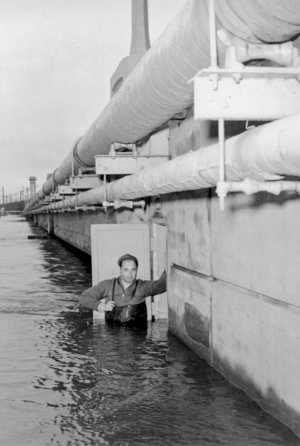
Manville suffers from occasional flooding events that occur after prolonged heavy rainfall events, when the Raritan River and Millstone River overflow their banks into the northern section (Raritan) and the Lost Valley section (Millstone) of the borough. The southern parts of Main Street also suffer from the flooding, due to the presence of Royce Brook which backs up with water from the nearby Millstone River in which it empties.
There are studies being undertaken to address the flooding problems in the Millstone River basin and Manville; however, none of the flood control ideas in the Millstone River basin have gotten beyond the initial study stages as of late 2006.
Hurricane Floyd flood of 1999
Manville was severely hit by a flood in the wake of Hurricane Floyd in September 1999, which dropped 10 to 12 inches (250 to 300 mm) of rain in the areas surrounding the borough. The floods devastated the Lost Valley section, some of the South side area along Main Street and a large portion of the North side. Water levels reached between 12 feet (3.7 m) and 17 feet (5.2 m) in parts of the borough on September 17, 1999. The only way residents could get help was by boat or helicopter. There was also a large amount of fuel oil floating on the flood water which further damaged homes, many of which came off their foundations.
A portion of the north side received water coming from the Raritan at Dukes Parkway. Much of the north side had no flooding. The water reached the freight tracks at Main Street, and spilled over, flooding some on the South Street side, but leaving tons of water dammed in on the North Street side, where people had to be rescued from rooftops, or second floor windows and landings, by boat.
The problem was doubled in the Lost Valley section, as flood waters backed up where the Raritan and Millstone rivers meet near the dam. All trapped and injured people had to be taken out by helicopter, as there was no way to get in or out of the Lost Valley section. The September 1999 flood disaster was the worst ever to hit Manville, although it had been flooded in 1971 during Tropical Storm Doria, when many of the Lost Valley houses were destroyed and their foundations lost, and previously before that in the 1950s. Because of the railroad tracks being so much higher than the Lost Valley land, Manville's Lost Valley will always be a number one target for flooding. Through research of Manville's history, Lost Valley was to remain open land due to the high risk of flood.
Lost Valley flooding
Manville has the distinction of being the location where the Raritan River (which passes to the north) and the tributary Millstone River (which passes to the east) join together, in the far northeastern corner of the borough. The Lost Valley section in eastern Manville is situated on the natural flood plain between the Raritan and Millstone Rivers, and bears the brunt of occasional flooding events which affect the river basins. The Lost Valley section is named so because it is generally disconnected from the rest of the borough with only a tunnel at Kyle Street and a bridge at Bridge Street crossing the railroad tracks to the neighborhood. Hurricane Floyd in September 1999 produced a particularly severe flood (a record for the river basins) in Manville, especially in the Lost Valley section of the borough, which experienced flooding all the way to the railroad tracks, with twelve feet or more water on many properties, which inundated houses with damaging flood waters. Another severe and devastating flood event occurred in Lost Valley during the April 2007 Nor'easter. It also left many homes and businesses underwater and was the worst flood since Hurricane Floyd. Flooding problems once again occurred in Manville on March 14, 2010, with rivers running already high due to recent snow melt along with three to four inches (102 mm) of rain that fell on the area on March 13, flooding was inevitable. More extensive flooding affected Manville in August 2011 when Hurricane Irene passed through New Jersey. In the aftermath of Hurricane Sandy in late October 2012, Manville did not flood but the powerful winds left many homes without power for several days.
Flood gauge on Raritan River
Flooding occurs at a 14-foot (4.3 m) stage, and severe flooding occurs when the water reaches 18 feet (5.5 m). The National Oceanic and Atmospheric Administration provides access to real time river level data.
Education
The Manville School District serves public school students in pre-kindergarten through twelfth grade. As of the 2019–20 school year, the district, comprised of four schools, had an enrollment of 1,601 students and 132.5 classroom teachers (on an FTE basis), for a student–teacher ratio of 12.1:1. Schools in the district (with 2019–20 enrollment data from the National Center for Education Statistics) are Weston Elementary School with 349 students in grades PreK-2, Roosevelt Elementary School with 234 students in grades 3-4, Alexander Batcho Intermediate School with 485 students in grades 5-8 and Manville High School with 450 students in grades 9-12.
Christ the King School, which opened in 1968 and served students in grades PreK-8, was closed by the Roman Catholic Diocese of Metuchen at the end of the 2014–15 school year in the wake of declining enrollment that had resulted in a $1 million deficit to the parish in the preceding five years.
Notable people
People who were born in, residents of, or otherwise closely associated with Manville include:
- Cheryl Chase (born 1958), voice actress.
- Joe Lis (1946-2010), Major League Baseball player.
- Joseph D. Patero (1932–2020), politician who served as mayor of Manville and in the New Jersey General Assembly from 1974 to 1986 and from 1988 to 1991.
- Edward Rogalski (born 1942), 12th president of St. Ambrose University in Davenport, Iowa, named in 1987.
- Theo Riddick (born 1991), professional football player for the Las Vegas Raiders.
- Robert Sikoryak (born 1964), cartoonist.
See also
 In Spanish: Manville (Nueva Jersey) para niños
In Spanish: Manville (Nueva Jersey) para niños


